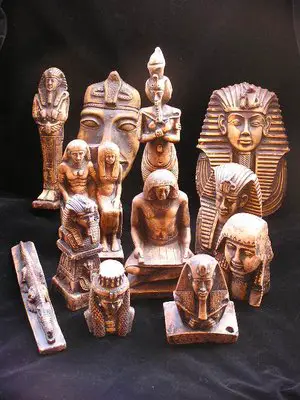In Egyptian Crafts, craftsmen in ancient Egypt were usually trained and skilled laborers. They were often well-respected in the community and had a comfortable lifestyle. Yet every craftsman’s lifestyle and social standing depended on the quality of his skills and experience. Thus, some craftsmen had more difficult lives than others.
 Most craftsmen worked in workshops with other craftsmen. Objects for temples or the pharaoh were made in temple workshops or palace workshops. Objects for ordinary people were made by local craftsmen in small workshops. As for painting, the Ancient Egyptians used primarily minerals from their desert environment. They ground up various minerals on stones and added a binding agent, usually an animal glue or some form of plant gum, before applying it to the surface.
Most craftsmen worked in workshops with other craftsmen. Objects for temples or the pharaoh were made in temple workshops or palace workshops. Objects for ordinary people were made by local craftsmen in small workshops. As for painting, the Ancient Egyptians used primarily minerals from their desert environment. They ground up various minerals on stones and added a binding agent, usually an animal glue or some form of plant gum, before applying it to the surface.
Egyptian Crafts and Arts

In ancient Egypt, all arts and crafts served one purpose: the Pharaoh. And the Pharaoh served one purpose: to ensure that the Nile overflowed its banks each year to flood the soil, fertilizing it so the crops would grow. The Pharaoh accomplished this by adhering to specific religious practices and performing rituals and sacrifices to honor Egypt’s many gods and gain their favor to give the Pharaoh and his people life.
The carvings and statues all served a purpose, of course, there was no such thing as having “art for art’s sake” back then. The carved reliefs, like the paintings, were stories and incantations – all for religious reasons. The statues were houses for the souls of the deceased. That is also why the ancient Egyptians made ritual offerings to the statues.

Ancient Egyptian art was rather the work of paid artisans who were trained and who then worked as part of a team. The leading master craftsman might be very versatile, and capable of working in many branches of art, but his part in the production of a statue or the decoration of a tomb was anonymous.
He would guide his assistants as they worked, and help to train novices, but his personal contribution cannot be assessed. Artists at all stages of their craft worked together. The initial outline sketch or drawing would be executed by one or more, who would then be followed by others carving the intermediate and final stages.
The Egyptians excelled at stone work, painting and metal work. They could pull huge granite columns and obelisks from the very rock using extremely primitive yet inventive techniques. Ancient Egyptian crafts and arts remained almost unchanged in the next thousand years until the Greek and later Roman conquest of Egypt when the occupiers began to use the artisans for their own purposes and less for the Pharaonic system of art for the state.